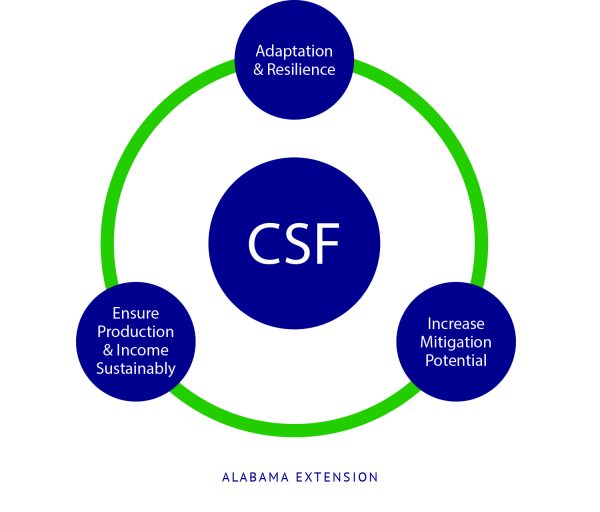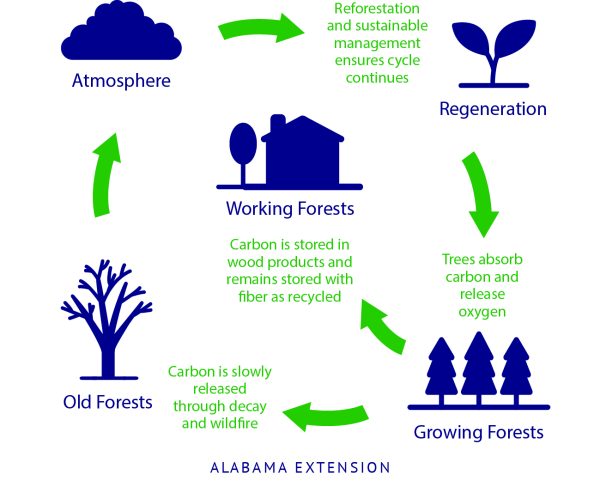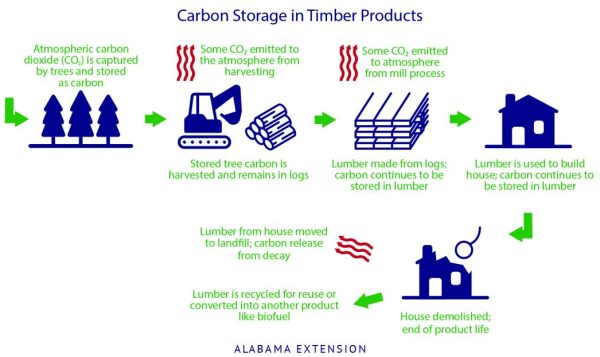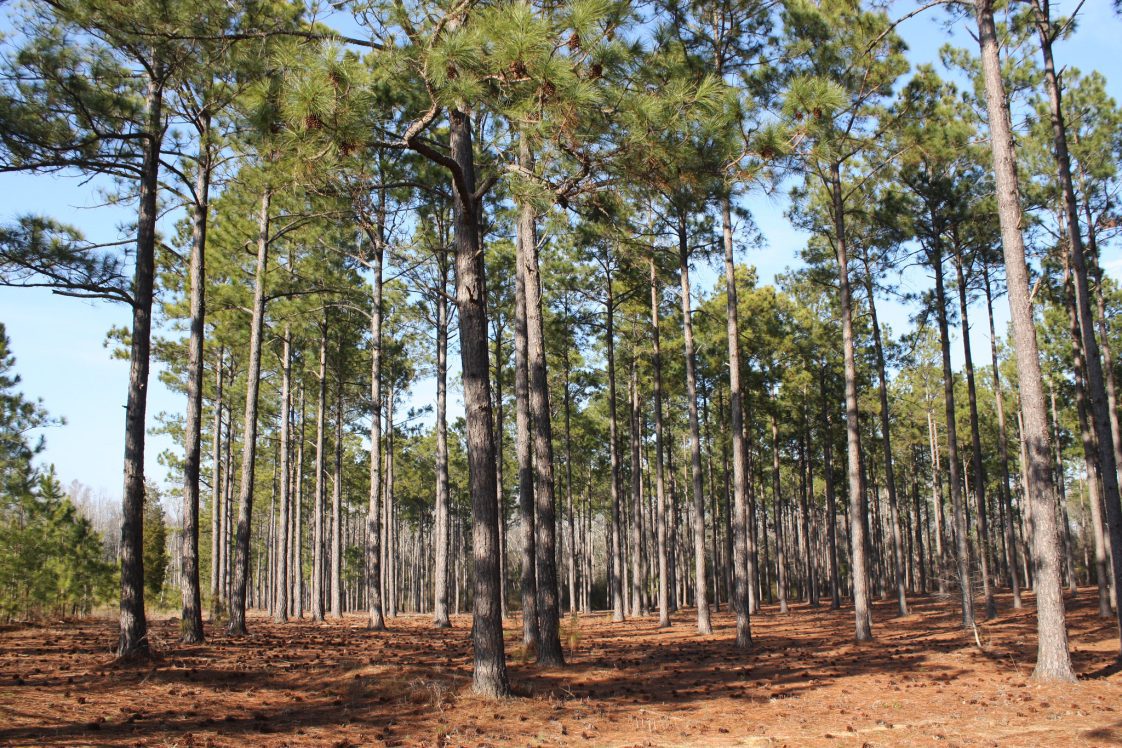Forestry

Climate-Smart Forestry (CSF) offers a natural climate solution to the rise of carbon dioxide (CO2) in the atmosphere. Benefits can range from reduced fossil-fuel use to increased forest biodiversity—while continuing to generate revenue for forestry operations.

Figure 1. The three objectives of Climate-Smart Forestry: adaptation, mitigation, and sustainability
Climate-Smart Forestry (CSF) is an approach to forest management that supports traditional practices to enhance forest growth, such as planting, thinning, and harvesting, along with modern objectives for carbon storage and ecosystem resilience. CSF is characterized by three main objectives (figure 1): (1) forest adaptation and resilience, (2) increased forest mitigation potential, and (3) sustainably ensured production and income.
To achieve the benefits of CSF, stakeholders need to understand CSF fundamentals. The good news is that CSF does not involve reinventing the wheel. Each of the objectives can be incorporated harmoniously with ongoing forestry practices.
Forest Adaptation
Proactive management increases a forest’s ability to adapt and develop greater resilience to disturbance. In an unmanaged forest, adaptability is left to chance.
As CO2 continues to increase in the atmosphere, research indicates that most forestland in the southern United States will experience increased temperatures, growing-season precipitation, severe weather events (hurricanes, floods), and insect infestation. To anticipate such changes, forest landowners must engage in proactive management that supports forest health and vitality.
Proactive forest management typically increases stand growth and economic returns. For example, traditional silvicultural tools, such as thinning, prescribed fire, and planting, enhance forest health, vitality, and revenue stream. Silvicultural tools also help support ecosystem services such as biodiversity, erosion control, drinking-water filtration, and air quality.
Thinning for adaptation is beneficial in different forest types. Timely thinning in an even-aged southern pine stand can increase tree vigor, improving resilience to drought events and insect attacks. In a pine hardwood stand, selective thinning can increase resource availability for drought-tolerant oaks and increase biodiversity and foraging opportunities for wildlife. Similar biodiversity and foraging results can be found when thinning a Coastal Plain longleaf pine stand to improve stand health and productivity and promote reproduction.
Prescribed fire is useful for a changing climate in many southern forests. Prescribed fire can create multicohort and multiage stands more resistant to insect outbreaks, drought, and hurricanes. Low-intensity fire can have similar results to thinning, encouraging the regeneration of fire-adapted and drought-tolerant longleaf and shortleaf pine.
If softwood or hardwood stocking is insufficient for natural regeneration, planting is helpful to jumpstart regeneration. Though more costly than natural regeneration, planting helps to ensure desired outcomes for stand regeneration and stand production. Planting also allows the appropriate species to be selected for a specific site to reduce potential insect and disease outbreaks.
Forest Mitigation

Figure 2. Sustainable forest management and forest carbon cycle with working forests (sustainably managed to produce forest products) and old forests
Mitigation focuses on increased stand growth and forest products. More forest growth leads to more forest carbon storage and potentially more carbon accumulation in timber products, lowering atmospheric CO2 (figure 2). The key to increasing carbon storage is active forest management.
Research shows that a stand with multiple harvests over 100 years stores additional carbon compared to a nonharvested stand over the same time. This difference is because a stand harvested three times over 100 years will produce three cohorts of fast-growing trees and long-lived wood products such as sawtimber. For example, standard southern pine practices that encourage aboveground growth, such as site preparation, weed control, and thinning, result in greater revenue and carbon storage in forest stands. Carbon, productivity, and revenue also can be accelerated in hardwood-dominated stands with thinning; however, carbon accumulation, tree productivity, and income likely will be lower than in a comparable pine plantation.
Sawtimber, pulpwood, and bioenergy products all help to store carbon. Sawtimber products typically store the most carbon due to trees being larger before harvest and then being used to produce long-lived timber products. In turn, sawtimber products, such as dimensional lumber, plywood, oriented strand board (OSB), and cross-laminated timber (CLT), store carbon in home framing and furniture items (figure 3). Pulp and paper products can even store carbon. Research has shown that if fiber-based pulp and paper products replace single-use plastics, greater carbon storage can occur, and fossil fuel consumption will decrease.
Carbon storage from woody bioenergy is more complex. Compared directly to coal-fired power plants, woody biomass–fired power plants store more carbon through reduced coal use and active forest management involved in the production of woody biomass. However, since large swaths of timberland are needed to feed biomass plants, the effects on long-term forest productivity and carbon storage can be difficult to predict. Additionally, both sawtimber and pulpwood mills sustainably use wood waste for electricity and heat, decreasing the need for fossil fuels.

Figure 3. Timber products, such as dimensional lumber, store carbon from tree harvest to end of product life
Sustained Production and Income
Provided producers accomplish forest adaptation and mitigation, sustained production and income should come naturally, even under a variable climate with more severe weather events.
Thinning supports forest health, vigor, and resilience under a variable climate. Sawtimber-sized trees can be harvested to store carbon in timber products. Properly timed thinning treatments can create consistent revenue streams through the sale of timber while supporting greater forest resistance to insects, pathogens, and drought conditions.
Prescribed fire reduces susceptibility to pests and promotes fire-adapted trees, foraging opportunities for deer, habitat for other game species, such as wild turkey or bobwhite quail, and habitat for nongame species, such as the red-cockaded woodpecker or eastern indigo snake. In turn, prescribed fire can reduce tree mortality and create desirable land for hunting leases. Prescribed fire can eliminate suppressed or undesirable trees, increasing resources to sawtimber trees and resulting in greater carbon storage.
Planting increases the rate of stand production and carbon storage. Improved nursery stock from planting can increase drought and cold tolerance, pathogen resistance, and stem form—factors that contribute to greater carbon gain. In the South, due to production gains, improved loblolly pine seedlings are the most popular softwood nursery stock, with longleaf, shortleaf, and slash pine as lesser components. Hardwood nursery stock is less common due to high establishment costs and longer rotations needed to produce high-value hardwoods, resulting in fewer nurseries offering improved hardwood stock.
Summary
Climate-Smart Forestry is new terminology for forestry management that meshes traditional practices with practices that address climate change realities. The approach has helped forest landowners realize that traditional forestry practices that encourage revenue also can encourage climate change adaptation and mitigation.
CSF is not a precise recipe that can be applied uniformly to southern forests. Not every stand is suited for adaptation, nor is every stand suited for mitigation. Therefore, every stand and forest requires careful thought and management to realize adaptation and mitigation objectives.
The good news is that change is likely within southern forests. Familiar strategies, such as thinning, prescribed fire, and planting, can help landowners prepare for change. To incorporate CSF, landowners can rely on trusted silvicultural tools while being mindful of adaptation and mitigation objectives.
Additional Resources
- Shephard, N. T., L. Narine, Y. Peng, and A. Maggard. 2022. “Climate Smart Forestry in the Southern United States. Forests 13, 1460. https://doi.org/10.3390/f13091460
 Noah Shephard, Graduate Research Assistant, Warnell School of Forestry and Natural Resources, University of Georgia, and Adam Maggard, Extension Specialist, Associate Professor, Forestry, Wildlife and Environment, Auburn University
Noah Shephard, Graduate Research Assistant, Warnell School of Forestry and Natural Resources, University of Georgia, and Adam Maggard, Extension Specialist, Associate Professor, Forestry, Wildlife and Environment, Auburn University
New May 2023, What Is Climate-Smart Forestry?, FOR-2139

